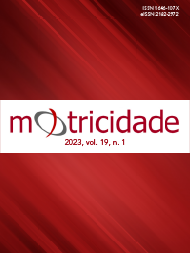Exercise training in children and adolescents with mouth breathing syndrome: a systematic review
DOI:
https://doi.org/10.6063/motricidade.28143Keywords:
Mouth Breathing, Posture, Exercise, ChildrenAbstract
The breathing pattern of Mouth Breathing (MB) implies the adaptation of body posture to facilitate the passage of airflow through the oral cavity, which can be prevented or reversed through physical exercise. However, there is no consensus on which is the best model of exercise program to minimise these postural adaptations. The purpose of the review was to investigate the effect of different physical exercise programs on the posture of mouth-breathing children and adolescents. The research was performed in Scopus, PubMed, Lilacs, Bireme, and Scielo databases in November 2022. The following descriptors were included: "mouth breather and exercise", "mouth breathing and exercise", "nasal obstruction and exercise", "mouth breather and exercises", "mouth breathing and exercises", and "nasal obstruction and exercises". Clinical trials related to the effect of physical exercise on the posture of MB children and adolescents were considered. Among 2796 identified studies, six were included. The mean score of the methodological quality scale of the selected studies was 5.5 points on a scale of 0 to 10. All studies showed an improvement in body posture after the exercise program. The exercise programs comprised muscle strengthening and stretching exercises, neuromuscular proprioceptive facilitation, and postural and diaphragmatic reeducation. The duration of the programs and the weekly frequency varied in the studies. Although it is difficult to compare studies and establish guidelines for formulating an exercise protocol, it was observed that upper limb strengthening and stretching exercises could effectively improve the body posture of MB children and adolescents.
Downloads
Published
Issue
Section
License
The authors of submitted manuscripts must transfer the full copyright to Journal Motricidade / Sílabas Didáticas Editions. Granting copyright permission allows the publication and dissemination of the article in printed or electronic formats, and copyrights start at the moment the manuscript is accepted for publication. It also allows Journal Motricidade to use and commercialise the article in terms of licensing, lending or selling its content to indexation/abstracts databases and other entities.
According to the terms of the Creative Commons licence, authors may reproduce a reasonable number of copies for personal or professional purposes, but without any economic gain. SHERPA/RoMEO allows authors to post a final digital copy (post-printing version) of the article on their websites or on their institutions' scientific repository.


